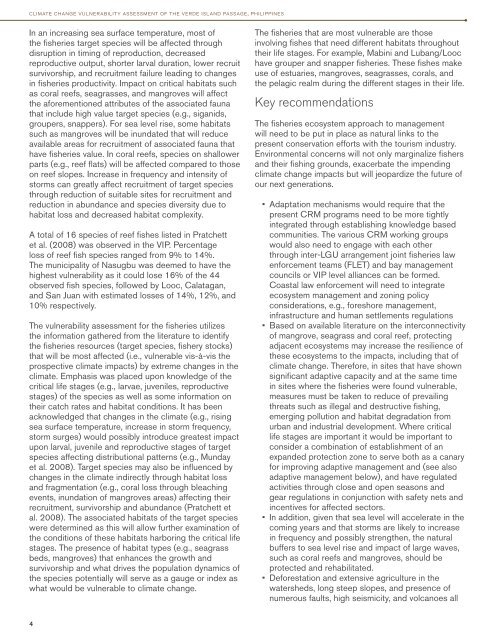of the Verde Island Passage, Philippines - weADAPT
of the Verde Island Passage, Philippines - weADAPT
of the Verde Island Passage, Philippines - weADAPT
You also want an ePaper? Increase the reach of your titles
YUMPU automatically turns print PDFs into web optimized ePapers that Google loves.
climate change vulnerability assessment <strong>of</strong> <strong>the</strong> verde island passage, philippines<br />
In an increasing sea surface temperature, most <strong>of</strong><br />
<strong>the</strong> fisheries target species will be affected through<br />
disruption in timing <strong>of</strong> reproduction, decreased<br />
reproductive output, shorter larval duration, lower recruit<br />
survivorship, and recruitment failure leading to changes<br />
in fisheries productivity. Impact on critical habitats such<br />
as coral reefs, seagrasses, and mangroves will affect<br />
<strong>the</strong> aforementioned attributes <strong>of</strong> <strong>the</strong> associated fauna<br />
that include high value target species (e.g., siganids,<br />
groupers, snappers). For sea level rise, some habitats<br />
such as mangroves will be inundated that will reduce<br />
available areas for recruitment <strong>of</strong> associated fauna that<br />
have fisheries value. In coral reefs, species on shallower<br />
parts (e.g., reef flats) will be affected compared to those<br />
on reef slopes. Increase in frequency and intensity <strong>of</strong><br />
storms can greatly affect recruitment <strong>of</strong> target species<br />
through reduction <strong>of</strong> suitable sites for recruitment and<br />
reduction in abundance and species diversity due to<br />
habitat loss and decreased habitat complexity.<br />
A total <strong>of</strong> 16 species <strong>of</strong> reef fishes listed in Pratchett<br />
et al. (2008) was observed in <strong>the</strong> VIP. Percentage<br />
loss <strong>of</strong> reef fish species ranged from 9% to 14%.<br />
The municipality <strong>of</strong> Nasugbu was deemed to have <strong>the</strong><br />
highest vulnerability as it could lose 16% <strong>of</strong> <strong>the</strong> 44<br />
observed fish species, followed by Looc, Calatagan,<br />
and San Juan with estimated losses <strong>of</strong> 14%, 12%, and<br />
10% respectively.<br />
The vulnerability assessment for <strong>the</strong> fisheries utilizes<br />
<strong>the</strong> information ga<strong>the</strong>red from <strong>the</strong> literature to identify<br />
<strong>the</strong> fisheries resources (target species, fishery stocks)<br />
that will be most affected (i.e., vulnerable vis-à-vis <strong>the</strong><br />
prospective climate impacts) by extreme changes in <strong>the</strong><br />
climate. Emphasis was placed upon knowledge <strong>of</strong> <strong>the</strong><br />
critical life stages (e.g., larvae, juveniles, reproductive<br />
stages) <strong>of</strong> <strong>the</strong> species as well as some information on<br />
<strong>the</strong>ir catch rates and habitat conditions. It has been<br />
acknowledged that changes in <strong>the</strong> climate (e.g., rising<br />
sea surface temperature, increase in storm frequency,<br />
storm surges) would possibly introduce greatest impact<br />
upon larval, juvenile and reproductive stages <strong>of</strong> target<br />
species affecting distributional patterns (e.g., Munday<br />
et al. 2008). Target species may also be influenced by<br />
changes in <strong>the</strong> climate indirectly through habitat loss<br />
and fragmentation (e.g., coral loss through bleaching<br />
events, inundation <strong>of</strong> mangroves areas) affecting <strong>the</strong>ir<br />
recruitment, survivorship and abundance (Pratchett et<br />
al. 2008). The associated habitats <strong>of</strong> <strong>the</strong> target species<br />
were determined as this will allow fur<strong>the</strong>r examination <strong>of</strong><br />
<strong>the</strong> conditions <strong>of</strong> <strong>the</strong>se habitats harboring <strong>the</strong> critical life<br />
stages. The presence <strong>of</strong> habitat types (e.g., seagrass<br />
beds, mangroves) that enhances <strong>the</strong> growth and<br />
survivorship and what drives <strong>the</strong> population dynamics <strong>of</strong><br />
<strong>the</strong> species potentially will serve as a gauge or index as<br />
what would be vulnerable to climate change.<br />
The fisheries that are most vulnerable are those<br />
involving fishes that need different habitats throughout<br />
<strong>the</strong>ir life stages. For example, Mabini and Lubang/Looc<br />
have grouper and snapper fisheries. These fishes make<br />
use <strong>of</strong> estuaries, mangroves, seagrasses, corals, and<br />
<strong>the</strong> pelagic realm during <strong>the</strong> different stages in <strong>the</strong>ir life.<br />
Key recommendations<br />
The fisheries ecosystem approach to management<br />
will need to be put in place as natural links to <strong>the</strong><br />
present conservation efforts with <strong>the</strong> tourism industry.<br />
Environmental concerns will not only marginalize fishers<br />
and <strong>the</strong>ir fishing grounds, exacerbate <strong>the</strong> impending<br />
climate change impacts but will jeopardize <strong>the</strong> future <strong>of</strong><br />
our next generations.<br />
• Adaptation mechanisms would require that <strong>the</strong><br />
present CRM programs need to be more tightly<br />
integrated through establishing knowledge based<br />
communities. The various CRM working groups<br />
would also need to engage with each o<strong>the</strong>r<br />
through inter-LGU arrangement joint fisheries law<br />
enforcement teams (FLET) and bay management<br />
councils or VIP level alliances can be formed.<br />
Coastal law enforcement will need to integrate<br />
ecosystem management and zoning policy<br />
considerations, e.g., foreshore management,<br />
infrastructure and human settlements regulations<br />
• Based on available literature on <strong>the</strong> interconnectivity<br />
<strong>of</strong> mangrove, seagrass and coral reef, protecting<br />
adjacent ecosystems may increase <strong>the</strong> resilience <strong>of</strong><br />
<strong>the</strong>se ecosystems to <strong>the</strong> impacts, including that <strong>of</strong><br />
climate change. Therefore, in sites that have shown<br />
significant adaptive capacity and at <strong>the</strong> same time<br />
in sites where <strong>the</strong> fisheries were found vulnerable,<br />
measures must be taken to reduce <strong>of</strong> prevailing<br />
threats such as illegal and destructive fishing,<br />
emerging pollution and habitat degradation from<br />
urban and industrial development. Where critical<br />
life stages are important it would be important to<br />
consider a combination <strong>of</strong> establishment <strong>of</strong> an<br />
expanded protection zone to serve both as a canary<br />
for improving adaptive management and (see also<br />
adaptive management below), and have regulated<br />
activities through close and open seasons and<br />
gear regulations in conjunction with safety nets and<br />
incentives for affected sectors.<br />
• In addition, given that sea level will accelerate in <strong>the</strong><br />
coming years and that storms are likely to increase<br />
in frequency and possibly streng<strong>the</strong>n, <strong>the</strong> natural<br />
buffers to sea level rise and impact <strong>of</strong> large waves,<br />
such as coral reefs and mangroves, should be<br />
protected and rehabilitated.<br />
• Deforestation and extensive agriculture in <strong>the</strong><br />
watersheds, long steep slopes, and presence <strong>of</strong><br />
numerous faults, high seismicity, and volcanoes all<br />
4
















